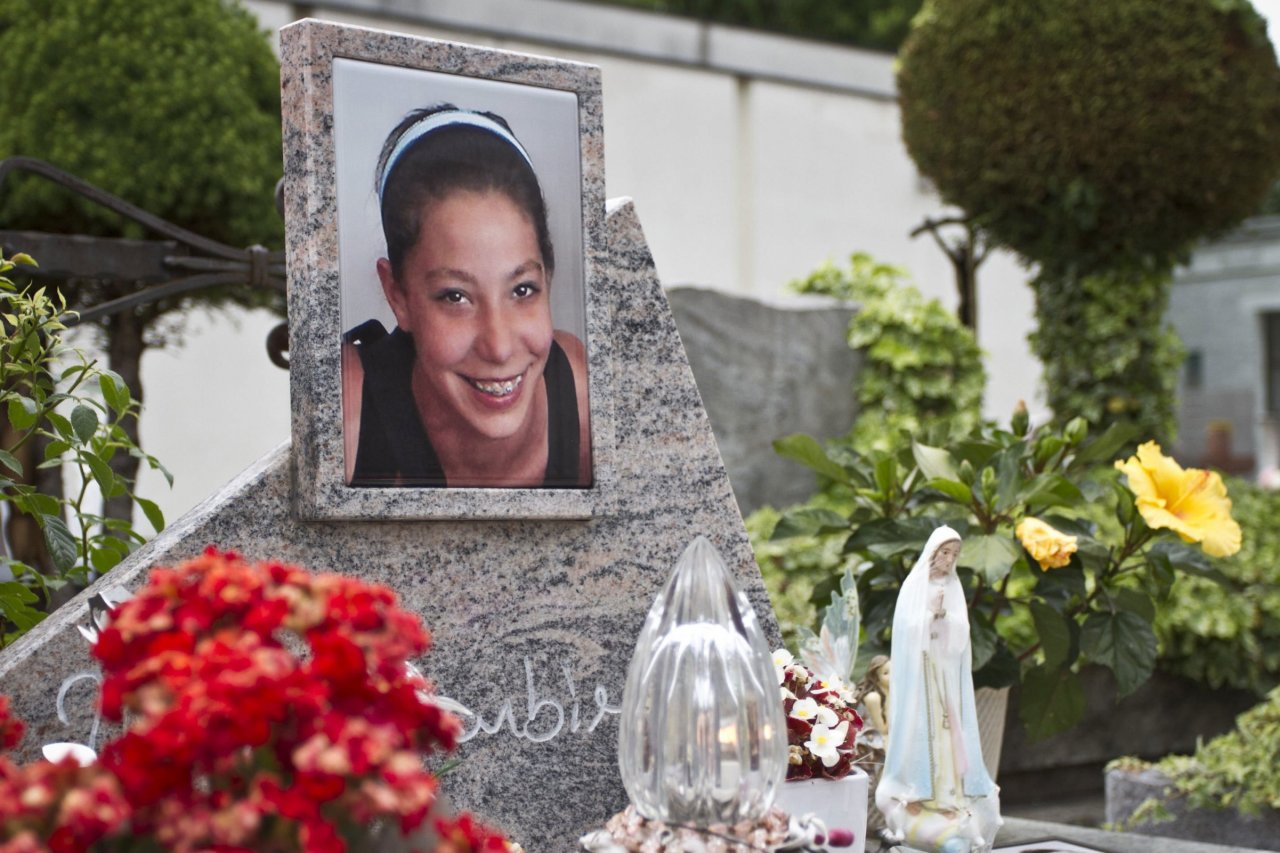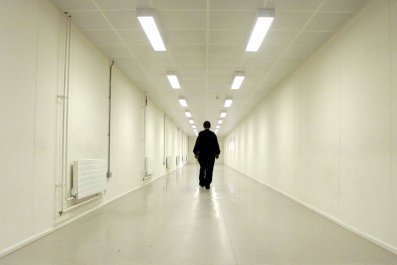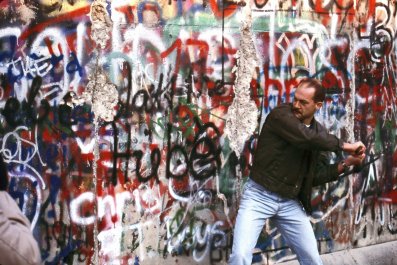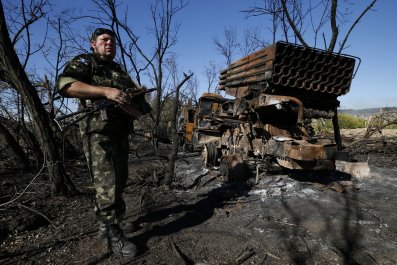When, in the autumn of 2012, police went to the home of the widow of a bus driver in a small town in northern Italy, they at long last struck lucky. The widow produced a box of documents that contained her husband's paper driving licence, to which was affixed a marca da bollo (a postage stamp used for tax purposes). Perhaps – they reasoned – the back of the stamp would contain the dead man's DNA, if, that is, he had licked the stamp himself before sticking it on to the licence.
The police had already DNA-tested so many people and documents in their search for the killer of 13-year-old Yara Gambirasio, in the two years since her death, that they did not hold out much hope of a breakthrough. So they were astounded when, a couple of weeks later, results came back from the lab showing that the DNA on the stamp was a close match to DNA found on the underpants and leggings of the murdered girl.
They had their man, or so it seemed, but they had a problem: he had died in 1999 – 11 years before the girl was murdered.
Yara Gambirasio, the daughter of a quantity surveyor, went missing on the evening of Friday 26th November 2010. It was snowing. At around 6pm she left a gym, 700 meters from her home, in a small, post-war satellite town, near the city of Bergamo, called Brembate di Sopra. It is the kind of place where nothing happens. It is hardly open even by day – not even its church. By 9pm, not a single bar is open.
As usual, Gambirasio, whose passion was gymnastics, set off alone and on foot from the gym. She never made it home. Her parents repeatedly tried to contact her on her mobile phone. There was no reply. At 7.30pm, they called the police. The snow got heavier.
Two weeks later, Mohamed Fikri, a Moroccan builder in the same town was arrested in connection with the case, after boarding a ferry to Tangiers from Genoa. Fikri was held for several weeks in custody but released when it became ever clearer that he was not the murderer.
Three months after Gambirasio's disappearance – on 25th February 2011 – her partly decomposed and frozen corpse was found in a field 10 kms from her home by a model aircraft enthusiast who was out flying his radio-controlled plane.
Yara had a dozen knife lacerations to her throat and back, which were too superficial to have caused her death. She had lost consciousness and died of exposure, investigators concluded. Despite the time that had passed since her death, police forensic scientists found several good samples of DNA material from other people on her corpse. Several thousand people attended her funeral at which a message was read from the Italian president. Her family have refused to talk to the media.
Lieutenant Colonel Michele La Russo of the Raggruppamento Opere Speciali (ROS) is the Carabinieri officer leading the murder investigation. He says: "Despite exposure to the wind, rain and snow those two DNA traces were excellent. And we were able to exclude saliva and sperm. So that left blood." Gambirasio had not been raped, says La Russo, but he adds: "There are many other ways to sexually abuse a girl, no?"
After Gambirasio's death, the police launched a massive screening programme which involved not just combing DNA data banks but administering 15,000 voluntary DNA tests on men and women, mostly men, living in the area. "Nothing so large had ever been attempted anywhere in the world before," says Giorgio Portera, a former Carabinieri lieutenant and now a geneticist employed as a consultant by the family of the dead girl, "let alone Italy". Or as the Rome daily Il Foglio put it: "There was launched an operation perhaps without precedent in the field of criminology and jurisprudence – the genetic screening of an entire territory."
Among those asked to undergo the voluntary DNA tests were young men who frequent a disco called Le Sabbie Mobili (Quick Sand) near the field where the dead girl's body was found. These included Damiano Guerinoni whose DNA was very similar to that of the killer, who was by now nicknamed by police "Ignoto Uno" (Unknown One). This young man was unquestionably a close relative of the killer. Ironically, his mother, Aurora Zanni, had even worked for several years as a daily help for the dead girl's family. So the police began to investigate his family. His father is one of 11 brothers and sisters. It was via this route that they arrived at the dead bus driver – one of his uncles – Giuseppe Guerinoni.
In September 2012 they went to the house of his widow, Laura Poli, in another small town near Bergamo called Clusone – 30km northeast of Brembate di Sopra, in the foothills of the Alps. Clusone boasts one of the most impressive surviving external medieval murals: "The Triumph of Death" executed in 1485 by Giacomo Borlone de Buschis. Its inscription declares: Non è omo così forte, che da mi non po' schapare (No man exists strong enough to be able to escape from me.)
It was in Clusone – nearly two years after Yara's disappearance – that they made their first breakthrough. "Finding the marca da bollo on the driving licence in the house of the bus driver's widow was a significant step forward," says Lieutenant Colonel La Russo, "It connected the killer with a real person at last – even if he was dead."
Giuseppe Guerinoni, who had died in 1999 aged 61 had three children with his wife who were quickly excluded as suspects. He was "a strong man able to live each day in symphony with his vital spirit", an old friend Antonio Negroni would later tell the press. It was clear, then, that he must also have had a child – a male child – out of wedlock and that this child was the killer. That the killer was a man rather than a woman was clear from the DNA samples found on the dead girl.
Yet, according to the former Carabiniere lieutenant Portera, and adviser to the family of Gambirasio, the DNA on the marca da bollo was "insufficient" because the DNA trace was "feeble" and he insisted that the body of the deceased man be exhumed. So, in March 2013, samples of his DNA were taken from one of his femurs. "That made it 100% sure," says Portera.
There was a total absence of old-fashioned clues as to the identity of the murderer; the only way to catch him was via modern science. So the police had to track down the illegitimate child of the dead bus driver and one way of doing that would be to identify his mother. But how could she be found? Guerinoni's widow was no help. She was in the dark about her dead husband's extra-marital activities and, like all the major protagonists in this saga, she has declined to talk to the media. The police reconstructed a biography of Guerinoni's private life and of every single woman he had ever known. "We were met by a wall of silence, the kind of omertà that you associate not with the north of Italy but with Sicily and the mafia, but in the end we got there by means of patient, painstaking legwork," says La Russo.
They located a former colleague of the bus driver, Vincenzo Bigoni, who told them: "Yes, he was a ladies' man and lots of young women travelled on his bus to and from work. One, at least, he got into trouble." But he was either unable or unwilling to reveal to police the name of that woman. He now risks prosecution for 'false testimony', which is a crime in Italy as there is no right to silence there.
The police tracked down the woman from her DNA. Police identified 532 women who the dead bus driver had known in his life with whom he could have had sexual relations and who were still alive. They DNA tested them all first in 2012 –2013 and again in 2014.
These women included Ester Arzuffi, now 67. Like all the other women identified by the police as women that knew Guerinoni, she consented to a DNA test without protest. Her DNA was a perfect match for that found on the dead girl – perfect in the sense that she is the mother of the killer, or so the investigators believed. "She has the female part of the DNA of Ignoto Uno," explains Portera.
Arzuffi has been married to the same man – Giovanni Bossetti – since 1967 when she was 19 years old. These days she and her husband also live in Brembate di Sopre. The couple have three children: two twins (a boy and a girl) born in 1970 – Massimo Giuseppe and Laura Laetizia – and a younger son – Fabio. The father of all three, everyone had always assumed, was her husband.
But the DNA tests revealed that the father of her twins is not her husband, but the dead bus driver Guerinoni. In other words, her eldest son – Massimo Giuseppe Bossetti – now stands accused of being the killer. "It's complicated but the female twin was excluded as a suspect because in females the chromosomes are different," explains La Russo. But could the bus driver not have had another illegitimate son – Ignoto Due, for example, or Ignoto Tre, with the same DNA – who killed the girl? "Yes, but those children could not be the killer because even though their DNA would be a close match it would not be close enough."
The police soon arrived at Massimo Giuseppe Bossetti, an apparently happily married 43-year-old carpenter who has three children aged 13, 10 and seven and whose only quirk seemed to be a passion for sun lamp massage parlours.
One Sunday evening in June 2014, the police set up a roadblock near Bossetti's home in Mapello, a village a few kilometers from Brembate di Sopra, and flagged down his car. He was with his wife and three children. They breathalysed him, and he passed, so they let him proceed. But they now had his DNA on the breathalyser tube which they swiftly sent off to the lab for analysis.
The match between the DNA on the breathalyzer tube and the DNA on the dead girl's clothing was clear. To be precise it showed 21 compatible markers (16 to 17 are normally considered enough). This means that the police, and their forensic experts are almost completely sure that he is the killer.
A few days later, on June 16th, the police arrested Bossetti at the building site where he worked. He has since been in custody in Bergamo. He refuses to speak except to say that he is innocent and that he does not understand how his DNA is on the dead girl's clothes. He has blue eyes, which the DNA that was found on the dead girl also reveals. This was a detail the Italian police discovered in the course of their inquiries from a visit to a lab in Washington DC with more sophisticated technology.
Bossetti's mother, Arzuffi, has spoken only once to the media – to the Corriere della Sera – when she denied having an affair with the bus driver but admitted that she had known him as a young woman. She waved aside the DNA match, describing it as "inexplicable", and said: "I did not have an affair with him unless my mind is playing me absurd tricks."
And yet, despite all the scientific evidence, there remain many doubts about the alleged culpability of Bossetti. For a start there is, so far, no evidence of a motive.
Meanwhile, two men came forward to tell magistrates that they had had affairs with Bossetti's wife. He last used his mobile phone on the night of the murder at 17.45, when he called his brother, who is a plumber, and then switched it off until 7.44 the following day.
A white Iveco truck, similar to his, was filmed by the security-cameras at the Shell petrol station opposite the gym in Brembate di Sopra at around 6pm and 10 minutes later by the video-cameras of the Banca Credito Cooperativo near the girl's home. But even if it were his van, so what? Bossetti went to the town frequently to see his brother and his accountant, and had passed through it the night of the murder on his way home from work, he says, to avoid the heavy traffic on the more direct route.
Bossetti's wife, Marita Comi, broke her silence only last month in a TV interview, in which she proclaimed her husband's innocence: "They cannot explain to us how his DNA was found on Yara's clothes," she said. "I have never had suspicions about him. We always ate dinner all together, at 7.30pm, at the latest 8pm, and he was always there – as he was that night."
There remain doubts as well about the accuracy of DNA analysis. On 19th August 2002, for example, a 24-year-old Italian woman Annalisa Vincentini, was shot dead in a pine wood on the coast near Livorno, in Tuscany. Several months later, the Italian police said that DNA traces found on her corpse matched "perfectly" those of a 23-year-old British barman from Liverpool, who, as a result, had been arrested by British police under an international arrest warrant.
DNA traces found in her car and on her corpse had been circulated throughout Europe and matched – so it was claimed – those of the barman, whose DNA had been tested in 2001 when he was arrested for drink-driving.
Yet according to some 20 witnesses, the barman was on duty in the pub where he worked in Liverpool on the day of the murder and furthermore he had never even been to Italy. There is now no suggestion that he is anything other than completely innocent. Subsequently, the British police admitted that they had bungled the DNA match between the samples sent from Italy and those of the barman in their DNA data bank. Several years later, a different man was convicted of the murder.
Indeed, in this case investigators had to do the DNA screening of the 532 women who might have had an illegitimate child with the bus driver twice. The first screening in 2012–2013 did not identify the mother of the killer whereas the second screening at the beginning of 2014 did.
The investigators ordered the second screening – according to some sources close to the inquiry – only after Antonio Negroni, the bus driver's close friend in Clusone, the town where he had lived – finally told a carabiniere officer, who also lives there, the name of the woman who was the mother of his illegitimate children: Arzuffi.
Lt Col La Russo denies the importance of this testimony and he also denies that mistakes were made in the first screening. "In the first screening, we tested only the nucleus in the DNA samples from the women, but we then discovered that the nucleus of the DNA on Yara's corpse was damaged and too poor for a match with the mother although it was fine for a match with the father," he says. "So we ordered a second screening in which we tested the mitochondria that surround the nucleus of the DNA which contains more female traces."
But as Silvia Gazzetti, the accused man's lawyer, says: "We have of course asked to do our own DNA tests because my client professes his innocence and is adamant that the DNA found on the deceased cannot therefore be his."
When news emerged in 2012 that the Italian police were seeking illegitimate male children of the bus driver, Giuseppe Guerinoni, in connection with the murder of Gambirasio, Bossetti did ask his mother: "Did you ever know Giuseppe Guerinoni?" He admitted this to magistrates. It is perhaps the closest thing they have to proof of his guilt, from a man who continues to protest his innocence – apart, that is, from that nearly perfect DNA match – of course.
Correction: This article originally made an error in describing a model plane as being radar-controlled when it was meant radio-controlled.
























